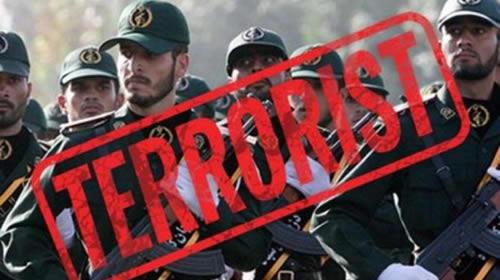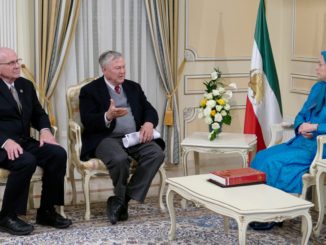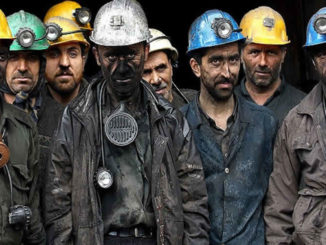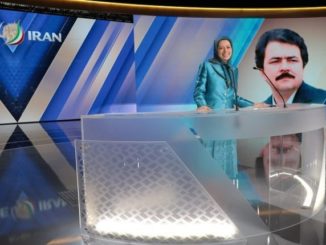
By Shahin Gobadi
Al Arabiya, 23 October 2017–The role of the Islamic Revolutionary Guards Corps (IRGC) in the attack on Kirkuk and various cities in Iraqi Kurdistan, which displaced a large number of people in the area, once again highlighted the IRGC’s destructive role in regional crises.
The Peshmarga Force commander said in Kirkuk on Sunday, October 15, ‘The Iraqi Army and Popular Mobilization Forces (Hashd al-Shaabi) are not the only ones who attack us. We have 100% accurate knowledge that the IRGC are also present among them.’ Qassem Soleimani, the head of the IRGC’s terrorist Quds Force, was plotting in Sulaimaniyah, Baghdad, and other areas of Iraq in the days immediately before the attacks.
Former US ambassador to Iraq, Zalmay Khalilzad, tweeted on October 11, ‘Quds Force Commander Soleimani is in Iraq, and pushing Hashtis to attack Kirkuk.’
Published news reports, photographs, and films confirm the presence of Hadi Al-Amiri and Abu Mehdi Mohandas, two Quds Force mercenaries in the attack on Kirkuk. Khalilzad wrote: ‘IRGC-backed militia led by terrorist Mahdi Mohandis has begun an assault in Kirkuk’ and, ‘Reliable reports indicate the PMF militia is using Abrams tanks provided by the US to the Iraqi armed forces.’
IRGC commander Jafari and Iran’s FM Zarif smile during meeting for the 40th anniversary of the Islamic Revolution, in Tehran.
In another tweet on October 16, Khalilzad asked, ‘Shouldn’t we disable these tanks to prevent their use by Quds force proxies?”
Documents and information proving that Mohandis and Al-Amiri are IRGC mercenaries have been disclosed by the Iranian Resistance since the 90’s. Both names were among the list of 32,000 Iraqi mercenaries of the Revolutionary Guards, which was disclosed by the Iranian Resistance on January 26, 2007.
In a statement, Senator John McCain, Chairman of the US Senate Armed Services Committee said on October 16: ‘I am particularly concerned by media reports that Iranian and Iranian-backed forces are part of the assault.”
IRGC Brigadier, Iraj Masjedi, the regime’s current ambassador in Iraq, is also a top commander of the Quds Force. He has played a key role in the regime’s terrorist operations, especially in Iraq and Syria throughout the past 30 years and has played an important role in the organization and command of the Hashd al-Shaabi.
Meanwhile, on October 17, 2017, IRGC Major General Mohammad Bagheri, Chief of Staff of the Armed Forces, entered Syria to intensify the IRGC meddling in that country and met with Bashar al-Assad and other leaders of the Syrian regime.
The intensification of the IRGC belligerence in Iraq and Syria has made more pressing the need for practical measures to evict the IRGC from Syria and Iraq and other countries in the region. This step is more imperative subsequent to the terrorist designation of the IRGC.
The following report is a glimpse into the black record of the IRGC, which was formed from the outset for the internal suppression and export of terrorism, the two pillars of the regime’s survival.
Warmongering and terrorism in the region
Javad Mansouri (the first commander of the IRGC in 1979 and the deputy minister of foreign affairs in 1981) said in an exclusive interview with the Quarterly Journal of Ramze Obour, affiliated with Supreme Leader Ali Khamenei’s faction in June 20, 2016: ‘Assistance to the movements (i.e. terrorist and extremist groups) had begun since 1979, and they would occasionally go to the section of Mr. Rafighdoost, who headed the IRGC’s logistics unit, and would get money, weapons, and location.”
He added: ‘Since April 1981, the Office of the Movements was officially established in the IRGC… In 1981, Martyr Rajai was the head of the Foreign Ministry and I was his deputy and we had regular meetings. At one of the meetings, I told him that there are eight entities that receive money from the government for the export of revolution activities. You gather the officials of these eight institutions and appoint one person and tell him I will give the budget to this person and he will divide it and everyone must be accountable to him.’
About IRGC control of the regime’s foreign policy, Mansouri said: ‘A number of foreign policy issues are not within the purview of the Foreign Ministry. For example, the Iraq, Lebanon, Afghanistan dossiers and the Bosnian issue and the Bosnian dossier at the time of its peak are among those cases. Some individuals, including Abbas Araghchi [the current Foreign Affairs Deputy Minister and the main negotiator in the nuclear agreement] have a history of Quds Force and the Quds Force had introduced them to the foreign ministry. They are its members; now our ambassador in Iraq, and former ambassador are members of the Quds Force. Lebanon and Syria, same thing… [The Quds Force] is somehow an evolution of the Movement Unit. In the sense that in addition to what they do, they mega plan, and they may even specify tasks for different organs in the country, such as radio and television! Say this or don’t say that about Iraq. This was not the case before. Or, for example, university! Accept this number of forces that we introduce to you and enroll them to come here and study here. These are our forces and we will need them later.’
The Quds Force commander Major General, Qassem Suleimani (C), attending a meeting of Revolutionary Guard’s commanders in Tehran.
In addition to the eight-year war between Iran and Iraq, the IRGC plays a major role in inflaming, expansion or continuation of several other major wars in the Middle East, such as those in Iraq, Syria, Yemen, and Lebanon, whose casualties and displacements after are unprecedented after World War II.
– In Iraq, after 2003, hundreds of thousands have been killed and several million displaced by direct intervention of the IRGC and its mercenary militias.
– In Syria, after 2011, more than 500,000 people have been killed and more than half of the country’s population have been displaced.
– In the Yemeni war, thousands of people have been killed and three million people have been displaced according to the UN report.
– The IRGC has either active terrorist and fundamentalist interventions or is engaged in creating espionage and terrorist networks and sending weapons to Bahrain, Egypt, Palestine, Jordan, Afghanistan, Saudi Arabia, Turkey, Kuwait, Pakistan, Azerbaijan, and Armenia.
– One of the hundreds of Quds Force terrorist operations is the bombing that targeted the US Marines Corps in the Saudi Arabia’s Khobar Towers on June 25, 1996, killing 19 Americans and injuring about 400 people. The operation was conducted under the command of Brigadier General Ahmad Sharifi, Commander of the Quds Force section known as section 6,000.
Internal suppression
During the past 38 years, the IRGC has played a major role in domestic repression, including the bloody suppression of the uprising of students in Tehran in 1999 and the uprising in 2009. After the uprising, in September 2009, the IRGC transformed its Intelligence Directorate to an independent organization known as the IRGC Intelligence Organization to increase its suppression and control over people. The IRGC’s intelligence organization is dreaded for its major role in arrests, torture and execution, and the assassination of opponents and in spying even against internal factions of the regime.
Since 2008, the IRGC has changed its entire organization to confront popular uprisings because, according to the IRGC assessment, this is the most serious threat to the regime. Thus, an independent command was formed in each province to control the population and suppress general uprisings.
During the demonstrations and protests in Iran, especially during the 2009 uprising, the IRGC, Bassij and plainclothes forces brutally beat and insulted protesters, especially young people and women, and murdered, wounded or arrested and tortured large numbers of people.
Members of the IRGC cheer during the speech of Iran’s Supreme Leader Ayatollah Ali Khamenei on the occasion of IRGC Week in Tehran 13 November 1999.
IRGC Brigadier General Hossein Hamedani was the commander of the Greater Tehran IRGC and the headquarters of Sarallah (the center for coordinating the entire repressive entities in Tehran) during the 2009 uprising until his deployment to Syria in 2011. He was one of the highest ranking commanders of the IRGC and was killed in Syria on October 8, 2015.
In his last interview with Javan Hamedan in June 2015, he confessed that planning for the suppression of the people of Tehran was done at the Sarallah base and that during the uprising, he had organized 5,000 people described by him as thugs and mobs in three Bassij battalions. To suppress the people, he explained, ‘We should take such people who know how to deal with the buckle and the cuff’.
Plunder
With the support of Khamenei, the IRGC controls Iran’s main economic joints in various areas and generates billions of dollars of revenue outside the control of official organs, which, in addition to its official budget, is used for suppressive and terrorist plans. As an example, Khatam Al-Anbia Headquarters, with more than 800 companies registered in Iran and abroad, controls widespread sectors of the country’s economy.
Hassan Rouhani said on April 18, 2017 that since he took office, the defense budget had grown by 145% compared, most of which was dedicated to the IRGC, missile programs, the financing of the Syrian and Iraqi wars, the transfer of arms to the Houthi and the financing of criminal militias.
According to internal reports, the IRGC provides more than 2.4 million tomans (equivalent of $600) per month, to the Iraqi, Afghan, Pakistani and Lebanese mercenaries dispatched to Syria. This is despite the fact that the minimum salary of workers in Iran is one million tomans (equivalent of $250) and most of them do not receive even this insignificant salary for a long time.
Public hatred towards the IRGC inside and outside Iran
The IRGC is loathed by the Iranian people due to internal repression and foreign interference. One of the students at the University of Tabriz in the presidential election on April 22, 2017 addressed one of the IRGC’s missionaries by saying: ‘Your theory is the theory of terror and the export of weapons and war, and the protection of the tyrant, bloody Bashar al-Assad… Yeah, your theory, is playing with the national and religious sentiments of the people and protecting the non-existing shrines of Homs and Idlib … Yes, your discourse is climbing on the embassies of the countries, your theory is spending the state budget for Hezbollah in Lebanon, which, according to Hassan Nasrallah’s confession, provides arms, livelihoods, food, and even their clothes from the budget of the people of Iran.’
In many recent demonstrations, people who have been denied their salaries for months have chanted, ‘Leave Syria, Think about us”.
On Sunday, October 15, 2017, thousands of people whose property was looted by institutions affiliated with the IRGC and other repressive organs rallied and marched in the streets of central Tehran, chanting: ‘We will not live under oppression, we give our lives for freedom, death to this oppression, death to this oppression’ and ‘our country is the house of thieves, it is an example in the world!’
An internal report from Lebanon in September 2017 states: ‘The presence of the IRGC and Hezbollah in Syria, from a strategic point of view, will have major losses on Hezbollah, the Islamic Republic and all of the Shiites. The Lebanese people and the Syrian refugees in Lebanon are all against the Islamic Republic and Hezbollah. … We worked in Syria for 30 years, and we invested and paid a lot of money. It is now completely smoke, and everything was destroyed by this war, and the Syrians became pessimistic about Iran.’
Necessary steps:
Since the IRGC is the main cause of suppression and killing in Iran and of crises in the region, and since it has therefore been designated as a terrorist entity the terrorist list, a number of practical measures, including the following, are extremely important:
1. Imposing comprehensive sanctions against the IRGC and its internal and external partners and its commanders and mercenary groups.
2. The expulsion of Guards and mercenary militias from Iraq, Syria, Yemen, Lebanon, Afghanistan and other countries of the region.
3. Preventing the travel of the IRGC and its commanders, such as Qassem Soleimani, to the countries of the region, and expelling from the region those who are already there, such as the regime’s ambassador to Iraq, Iraj Masjedi.
4. Preventing the sending of weapons and troops to countries of the region by land, air or sea, and imposing sanctions on airline companies that are involved in the transfer of arms and weapons to the countries of the region.
5. Preventing the mullahs’ regime, especially the IRGC and the Ministry of Intelligence, from accessing the global banking system, on the grounds of its potential contribution to the regime’s role in international terrorism.




